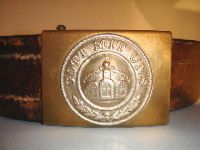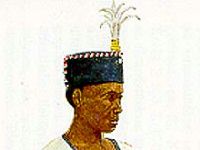German New Guinea
Micronesian Polizeitruppe Other Ranks and
Auxiliaries |
 |
 |
 |
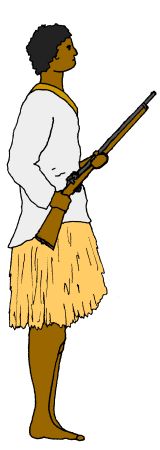 |
|
Figure 1
Polizei-Soldat
Yap, West
Caroline Islands |
Figure 2
Polizei-Soldat
Saipan, Mariana Islands |
Figure 3
Polizei-Soldat
Caroline Islands |
Figure 2
Auxiliary Soldier
Ponape, East
Caroline Islands |
After the establishment of
German New Guinea on Kaiser-Wilhelmsland and the Bismarck Archipelago in
1884, the colony gradually spread Northwards taking control many of the
islands of Micronesia. The Caroline and Marshall Islands became part of German
New Guinea in 1885, as did Nauru in 1888 and finally the Marianas in
1899 (except American Guam).
Also in 1899 the first Polizeitruppe were
established on these islands, under the command of a handful of German
Polizeitruppe NCOs. The other ranks were recruited from Malays in the Dutch
East Indies. Some, but not all, had previous military experience in Dutch
service. There were originally 12 in the West Carolines, 22 in the East
Carolines and 12 in the Marianas.
Later some Micronesian Polizeitruppe were recruited locally
as well as more Malays being employed. To defeat the Sokehs Rebellion on
Ponape in the East Caroline
Islands in 1910,
Melanesian Polizeitruppe soldiers were brought in (together with the guns and landing parties of the SMS Emden, SMS Comoran and SMS Nürnberg).
After the rebellion Melanesian Polizeitruppe
soldiers were permanently stationed there to deter future revolts.
Melanesian Polizeitruppe also served on
Nauru.
By the outbreak of the First World War the numbers of
police in Micronesia had increased to 71 in the West Carolines, 122 in the
East Carolines, 30 in the Marianas, 39 in the Marshalls and 21 on Nauru. These
numbers were not enough to defend against the Japanese Navy which took all
the islands without resistance between 29th September and 21st
October 1914. The only thought of resistance was on Ponape, where deputy
District Officer Koehler and two
German Polizeitruppe NCOs retreated into the bush with about 50 Melanesian
Polizeitruppe to plan a defence. After seeing the size of the Japanese
landing force they wisely surrendered. Uniforms of the
Micronesian Polizeitruppe
The Micronesian Polizeitruppe wore
several types of uniform, often in combination with each other. Some were
the same as worn by the Melanesian Polizeitruppe on New Guinea, but other
items were unique to Micronesia.
White Naval Style Uniform
The Micronesian Polizeitruppe were
issued a white naval style uniform (as also worn by the
Cameroon Schutztruppe).
This consisted of a white top with short sleeves, edged around the wide collar
in blue. It had three horizontal blue bars across the chest. Some photographs
show these bars to have been quite thin and wide, while others seem to have been
thick and short. This top was accompanied by matching white three quarter length
trousers.
Loincloth
In addition they were issued the same dark red loincloth as worn by the
Melanesian Polizeitruppe. Some
photographs show Micronesian Polizeitruppe bare-chested wearing only the
loincloth, though it was not unusual to see the white top worn with the dark red
loincloth.
Khaki Naval Style Uniform
A khaki naval style top (also worn by the
Melanesian Polizeitruppe
and the
Cameroon Polizeitruppe)
was also sometimes issued. It had red edging on the naval collar and around the
cuffs. Matching three quarter length khaki trousers were worn. NCO rank insignia
was worn in the form of red chevrons on the upper left sleeve of the khaki top
(see
NCO Rank Insignia Page)
by Melanesian NCOs and so also presumably by Micronesian ones. Judging from
period photographs it was not commonly worn and may only have been issued to
NCOs as some photographs show other ranks topless or wearing the white naval top
while only the NCO has a khaki top. This top was accompanied by matching khaki
three quarter length trousers. Some photographs show khaki or off white trousers
worn with the white top.
Local Adornments
Surprisingly the German authorities seem to have tolerated the islanders
habit of wearing non-uniform adornments while in Polizeitruppe service.
These adornments consisted of plaits of plant fibres adorned with seashells,
animal bones and teeth, pieces of coral, beads, agate, coloured stones or
even large insects. They could be worn around the upper arms, wrists, neck,
ankles or in the hair. Micronesian Polizeitruppe were not issued boots or
puttees and all period photographs show them barefooted.
Headdress
The headdress of the Micronesian Polizeitruppe
came in various forms, though many of them went without headgear at all.
Some had short cropped hair, while others had large Afro-style haircuts some
decorated with locally made adornments (see above).
Straw Hat
The straw hat held up on the right hand side with a large imperial cockade
(as originally issued to the East
Asian Expeditionary Corps) was commonly worn by the Micronesian
Polizeitruppe.
Südwester Hat
Some photographs taken in the Marianas show the Polizeitruppe wearing what
appears to be a Südwester hat with a dark coloured hatband and edging and a large
imperial cockade holding up the right hand side. The colour of the hatband
and edging is impossible to tell for certain from the original black and
white photographs. It may have been red as worn on the
peaked cap and commonly seen on most Polizeitruppe headgear in all colonies.
Likewise it is difficult to be sure if the hat is made from grey felt, as
worn by the Schutztruppe in Africa or possibly straw or Hessian type
material (see below).
Field Cap
The dark
khaki peaked cap (as worn by the
Melanesian Polizeitruppe) with a red
hatband and small imperial cockade was also issued to some Micronesian
Polizeitruppe (some photos showing only NCOs wearing them).
Yap Parade Cap
Another very curious
item of headgear has been seen in contemporary illustrations but not (so far)
confirmed in photographs. The illustrations (such as those in the 1920 "Deutsches Kolonial Lexicon" and the
1933 Waldorf-Astoria cigarette card set- see Contemporary
Illustrations Page) show Polizei-Soldaten on Yap (or "Jap" in German)
in the West Caroline Islands wearing a peakless blue cap on parade, edged along
the top and rear with a twisted cord in
the imperial colours, with a white feather plume at the front possibly held with
an imperial cockade (see below right). Please
contact me here if you have photographs of this
curious headdress.
Equipment
Brown leather equipment was carried,
usually simply in the form of a belt with a naval other ranks belt
buckle (see above) and two 1871/95 ammunition pouches. One photograph
shows the only equipment worn to be a small single semi-circular pouch on a thin belt. I have not been able to identify the
purpose or source of these pouches.
I have seen no photographs showing
the Micronesian Polizeitruppe carrying any more equipment, however an
illustration in the "Deutsches Kolonial-Lexikon" shows a
soldier of the Carolines Polizeitruppe carrying the same equipment as worn by
the Melanesian Polizeitruppe. It consisted of a water bottle, metal canteen, groundsheet and a large backpack. This backpack was not of the pattern usually issued to the German army (or colonial
troops) but of a loose shape and appears to be similar to the "Seesack"
carried by the German navy (see
Naval Equipment Page).
Weapons
The Micronesian Polizeitruppe were mostly armed with Mauser G71 rifles with S71
bayonets, though some photographs show Mauser carbines also in use.
The Illustrations
Figure 1 is based on a
photograph of a Micronesian
Police Soldier ("Polizei-Soldat") taken in 1910 on Yap in the West Carolines.
He wears the dark brown peaked cap with red hatband and piping and small
imperial cockade, white naval top with blue edging and chest stripes and the
dark red loincloth (folded up quite short) all of which were standard issue for
the Micronesian Polizeitruppe. His equipment consists of two 1871/95 ammunition
pouches worn on the standard leather belt and naval belt buckle. His rifle is the Mauser G71 with an S71
bayonet.
It may be that this
Polizei-Soldat is an NCO, though no rank insignia was known to be worn on the
white naval top. The other Polizei-Soldaten in the original photograph upon
which this illustration is based are less uniformly dressed. All wear the
lioncloth, half have the white naval top but none wear any headdress. They all
have the same 1871/95 ammunition pouches, though some only have one, all worn on
the standard leather belt and naval buckle. Most are armed with the G71 though
some have carbines, all fitted with the S71 bayonet.
Figure 2 is based on a
photograph of a Micronesian Police Soldier taken in 1903 on Saipan in the
Marianas. He wears a Südwester style hat held up on the right hand side with a
large imperial cockade. It is impossible to tell from the original photograph
upon which this illustration is based the colour of the hatband and edging, it
may have been red as worn on the peaked cap and commonly seen on most
Polizeitruppe headgear in all colonies. Likewise it is difficult to be sure if
the hat is made from grey felt, as worn by the Schutztruppe in Africa or
possibly straw or Hessian type material (see above). He wears the white naval top
but with khaki three quarter length trousers. He carries a single 1871/95
ammunition pouch unusually worn in the centre. His rifle is most likely the Mauser G71
and a scabbard probably for the S71 bayonet can be seen on his left side.
Figure 3 is based on a
photograph of a Micronesian Police Soldier taken in the Carolines,
possibly in 1909. He wears the straw hat held up on one side with a
large imperial cockade. Südwester and straw hats were usually worn with the brim
held up on the right hand side, this Polizei-Soldat appears to be wearing his
hat backwards. He wears a white naval top and matching trousers. The belt and
buckle are of standard naval issue. He does not appear to be carrying any
ammunition pouches, though one may be hidden from view on his right hand side. His rifle is again the Mauser G71 with
an S71 bayonet.
| |

Bali Polizeitruppe Soldiers
The caption to this photographs says
that it shows Leutnant Hutter with a unit of Bali soldiers.
These were presumably some of the first recruited in the Dutch
East Indies for service in German Micronesia in 1899. Their
uniforms cannot be clearly seen. Hutter appears to wear a khaki
uniform with a wide brimmed hat while the Bali soldiers may be
wearing red lion cloths.
Photo ©
Frankfurt University Koloniales Bildarchiv
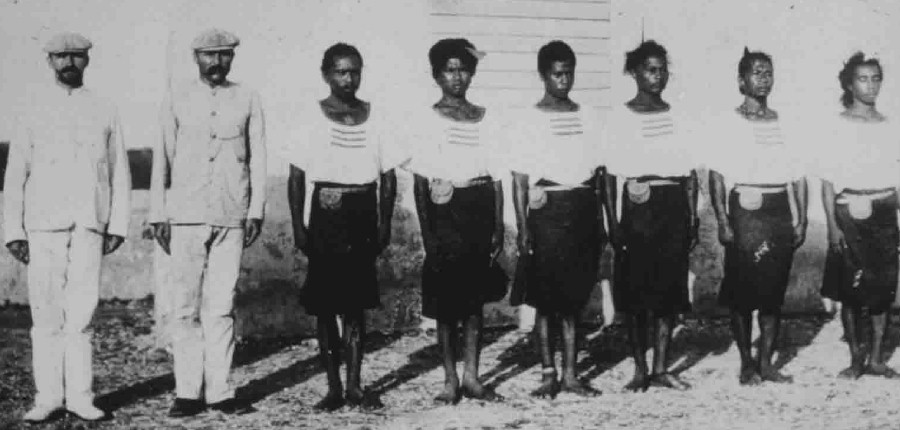
Carolines Polizeitruppe
The two German police NCOs wear white (or possibly khaki) tropical
uniforms without insignia but with casual civilian flat caps. The other
ranks have no headdress but wear the naval style top with three blue
bars across the chest and dark red sarongs. The pouches they carry may
be locally made as they do not appear to be similar to anything of
German issue.
Photo ©
Frankfurt University Koloniales Bildarchiv
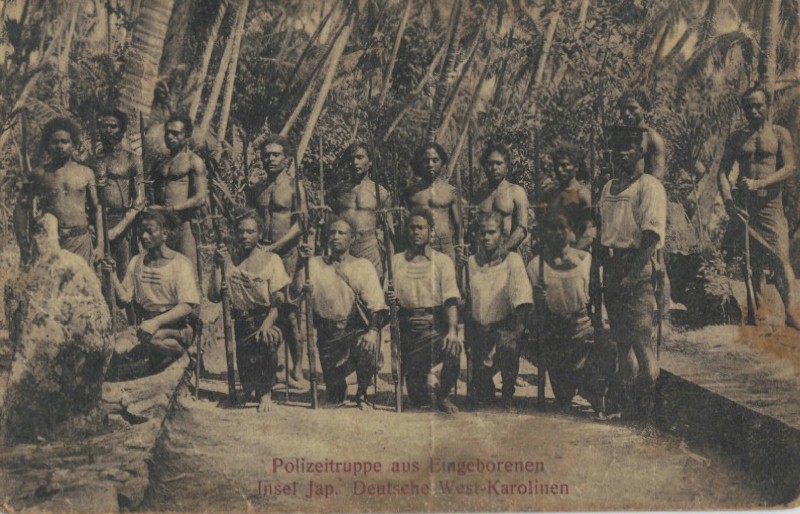
West Carolines Polizeitruppe
This photograph shows Polizeitruppe on the Island of Jap. All
wear the dark red sarong, some wear the white naval style top
with
blue stripes on the chest and only one on the right (possibly the NCO) wears a
khaki field cap.
Photo © Mark Skurka see For
Sale Page
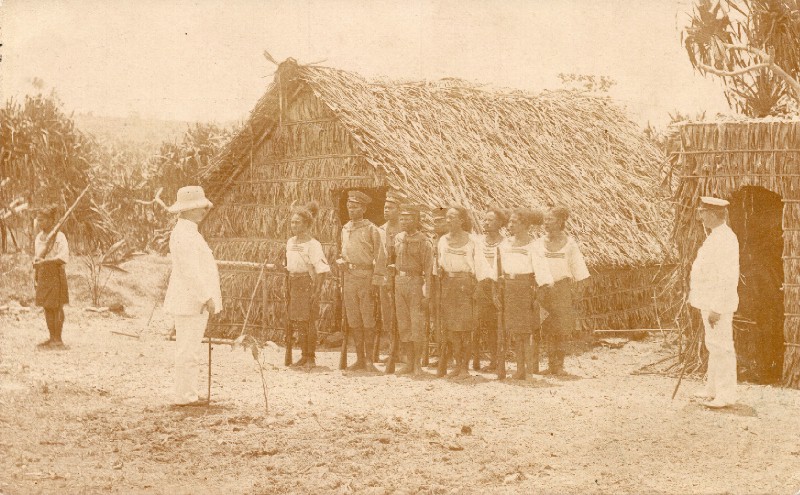
Pacific Polizeitruppe
This photograph shows the German Pacific Polizeitruppe. It
was sent as a postcard from Yap in the German Carolines but
written in Angaur a German island off Palau on 16th
September 1911. As such it most likely shows the German
garrison on Angaur, an important phosphate mining base.
The German NCOs wear white
tropical uniforms with no visible insignia. The man on the
left wears a white tropical helmet that is most likely
privately purchased. Then man on the left wears a white
peaked cap with what may be a red Polizeitruppe hatband.
The Pacific other ranks wear
two different styles of uniform and seem to be from different
garrisons. Note also the different facial features of each
group being from different ethnicities.
One half of them wear red
sarongs, white naval style tops with three blue stripes
across the chest and no headdress. They are armed with the
JB71 rifle and what appears to be the S71 bayonet. They
carry a single ammunition pouch on a brown leather belt with
a plain buckle. These are probably the local Angaur
Micronesian soldiers.
The other half wear a khaki naval style uniform with field
cap. The edging on the uniform and the hatband of the cap
would have been red. They also carry a single ammunition
pouch on a brown leather belt with a plain buckle. Note the
water bottle carried by one. Their rifles are the Gew88 but
their bayonets cannot be identified. These soldiers in khaki
are probably from the mainland New Guinea
Melanesian
Polizeitruppe.
Photo
©
Karsten Herzogenrath -
see
close up details of this photograph here |
|
Locally Recruited Auxiliary
Soldiers
Unlike in the African colonies, Pacific Islanders were not regularly used as
auxiliary soldiers by the German forces. Local tribesmen were sometimes employed
as scouts, and porters were locally recruited for German expeditions but not
usually as combatants. However when the Sokehs Rebellion broke out on Ponape in
1910, the District Officer was compelled to hire warriors from other local
tribes to defend German lives and possessions. These Ponapean warriors do not
appear from photographs to wear any German uniform or insignia, simply wearing
their own clothing. They appear bare headed with roughly cut hair, often bare
chested or wearing a simple loose shirt and having a grass skirt around the
waist. It is unlikely that the District Officer would have had many German
weapons to spare for them, but many Ponapeans still retained their own stocks of
firearms before the rebellion.
Figure 4 is based on a
photograph of a Ponapean Auxiliary Soldier taken while in German service
on Ponape in 1910. He wears a loose fitting white shirt and a grass skirt. The
rifle is not clearly identifiable in the original photograph upon which this
illustration s based but is probably his own and of an obsolete pattern.
Recommended External Links-
Axis History
Forum Discussions on
World War I in the Pacific and
When Germany lost the Marshall Islands
Südsee Polizeitruppe
at Kukri.de
The Photo albums on the
Micronesia Over the
Years website
Recommended Published Sources-
"Rebellion in der Südsee"
by Thomas Morlang
(Published by
CH Links)
"Askari und Fitafita - Farbiger Söldner
in den deutschen Kolonien" by
Thomas Morlang
(Published by
CH Links)
"Die Deutsche Schutztruppe 1889/1918" by Werner Haupt
(Published by Dörfler)
"Rivals Of The Raj:
Non-British Colonial Armies in Asia 1497-1941"
written and illustrated by Peter Abbott
(Published by
Foundry)
"Uniforms of the German Soldier - 1870 to the
End of World War One" by Alejandro M. De
Quesada
(Published by Greenhill)
Special thanks to Bruce Swanton, Thomas
Morlang, Per Finsted and "Scarlet" on the
Axis History
Forum for their help in researching
this page.
|




